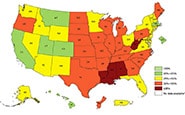FROM THE Centers For Disease Control and Prevention...Adult Obesity FactsObesity Prevalence MapsAdult obesity prevalence by state and territory using self-reported information from the Behavioral Risk Factor Surveillance System.
Obesity is a common, serious, and costly disease
From 1999 –2000 through 2017 –2018, US obesity prevalence increased from 30.5% to 42.4%. During the same time, the prevalence of severe obesity increased from 4.7% to 9.2%.
Obesity-related conditionsexternal icon include heart disease, stroke, type 2 diabetes and certain types of cancer. These are among the leading causes of preventable, premature death.
The estimated annual medical cost of obesityexternal icon in the United States was $147 billion in 2008. Medical costs for people who had obesity was $1,429 higher than medical costs for people with healthy weight.
Non-Hispanic Black adults (49.6%) had the highest age-adjusted prevalence of obesity, followed by Hispanic adults (44.8%), non-Hispanic White adults (42.2%) and non-Hispanic Asian adults (17.4%).
The obesity prevalence was 40.0% among adults aged 20 to 39 years, 44.8% among adults aged 40 to 59 years, and 42.8% among adults aged 60 and older.
Overall, men and women with college degrees had lower obesity prevalence compared with those with less education.
The same obesity and education pattern occurred among non-Hispanic White, non-Hispanic Black, and Hispanic women, and non-Hispanic White men. However, the differences were not all statistically significant. Although the difference was not statistically significant among non-Hispanic Black men, obesity prevalence increased with educational attainment.
No differences in obesity prevalence by education level were noted among non-Hispanic Asian women and men and Hispanic men.
Among men, obesity prevalence was lower in the lowest and highest income groups compared with the middle-income group. Researchers observed this pattern among non-Hispanic White and Hispanic men. Obesity prevalence was higher in the highest income group than in the lowest income group among non-Hispanic Black men.
Among women, obesity prevalence was lower in the highest income group than in the middle and lowest income groups. Researchers observed this pattern among non-Hispanic White, non-Hispanic Asian, and Hispanic women. Among non-Hispanic Black women, there was no difference in obesity prevalence by income.












